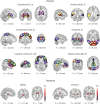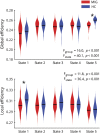Abnormal thalamocortical network dynamics in migraine
- PMID: 31076535
- PMCID: PMC6556096
- DOI: 10.1212/WNL.0000000000007607
Abnormal thalamocortical network dynamics in migraine
Abstract
Objective: To investigate the dynamic functional connectivity of thalamocortical networks in interictal migraine patients and whether clinical features are associated with abnormal connectivity.
Methods: We investigated dynamic functional network connectivity (dFNC) of the migraine brain in 89 interictal migraine patients and 70 healthy controls. We focused on the temporal properties of thalamocortical connectivity using sliding window cross-correlation, clustering state analysis, and graph-theory methods. Relationships between clinical symptoms and abnormal dFNC were evaluated using a multivariate linear regression model.
Results: Five dFNC brain states were identified to characterize and compare dynamic functional connectivity patterns. We demonstrated that migraineurs spent more time in a strongly interconnected between-network state, but they spent less time in a sparsely connected state. Interestingly, we found that abnormal posterior thalamus (pulvinar nucleus) dFNC with the visual cortex and the precuneus were significantly correlated with headache frequency of migraine. Further topologic measures revealed that migraineurs had significantly lower efficiency of information transfer in both global and local dFNC.
Conclusion: Our results demonstrated a transient pathologic state with atypical thalamocortical connectivity in migraineurs and extended current findings regarding abnormal thalamocortical networks and dysrhythmia in migraine.
© 2019 American Academy of Neurology.
Figures






References
-
- Delamillieure P, Doucet G, Mazoyer B, et al. . The resting state questionnaire: an introspective questionnaire for evaluation of inner experience during the conscious resting state. Brain Res Bull 2010;81:565–573. - PubMed
-
- Kucyi A, Davis KD. Dynamic functional connectivity of the default mode network tracks daydreaming. Neuroimage 2014;100:471–480. - PubMed
Publication types
MeSH terms
Grants and funding
LinkOut - more resources
Full Text Sources
Other Literature Sources
Medical
